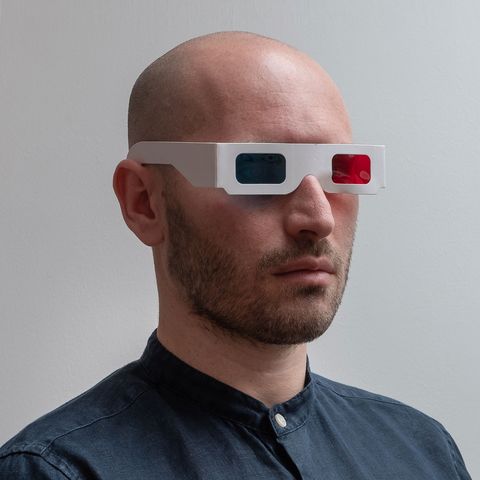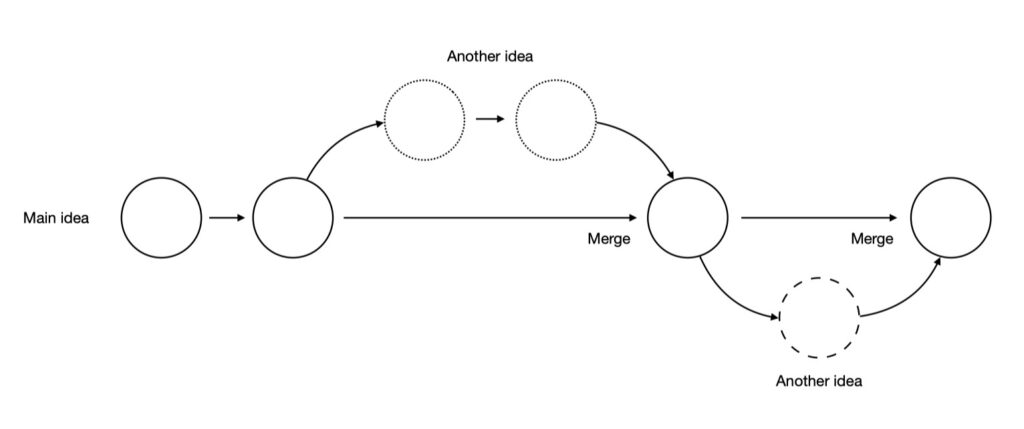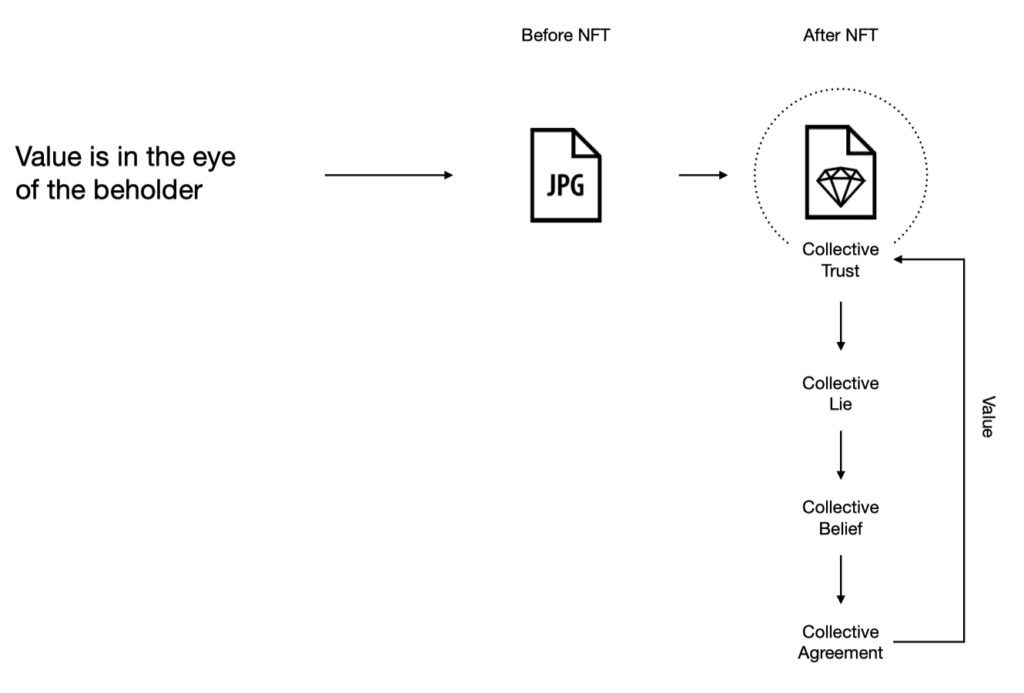Pau Waelder

Fabio Catapano is an Italian digital artist and designer who works with code, CGI, and motion. Encouraged by the possibilities that the NFT market has opened to digital artists, he is developing a growing body of work inspired by Japanese aesthetics and creating generative art that moves away from strict geometry and explores the poetic side of creative coding. On the occasion of his solo artcast A Theory of Color, we had a conversation about his creative process and his views on the future of digital art.
Fabio Catapano. Colorem 221201, 2022
What took you to create your artworks using generative algorithms and how would you describe your creative process?
It was the result of a series of choices. When I was younger, I worked for a long time as a VJ making visuals for clubs and musicians. In that process, you need to create a lot of video content, and I used a software called Quartz Composer, which is pretty much one of the first node-based generative system software programs. Besides my work as a VJ, I have always been passionate about programming languages and I learned some Visual Basic as a hobby. So I had both the interest and the motivation to use this software and explore the creative possibilities of generative algorithms. Since what I did is write the code and then the system would generate the outcome, I found it fascinating to ask myself who is the creator, me or the machine? I feel that we are co-creators, and the software is not just a tool, it is something else.
“I take cues from the way software developers think and collaborate, how they create iterations and updates of the same program.”
The initial idea for an artwork can originate in a shape, the feeling of motion, or a texture, colors, or the combination of two or more elements together. The process in itself is very, very experimental, a form of research in which every outcome is a good outcome. How the project develops is very spontaneous: for instance, I started two years ago with the series Colorem and I wasn’t expecting to create so many pieces. But I ended up creating day after day a different iteration of the same system in a way that felt as a journal of the whole process. I take cues from the way software developers think and collaborate, how they create iterations and updates of the same program. This is why the artwork titles include a reference number that indicates the date of creation and are therefore similar to the versions in a computer program.

Every day there is a different outcome and a different exploration, that may be driven by a series of colors, or shapes, or something that I did before. Sometimes I want something that is a bit more grainy, or a bit more clean. But none of those, in my opinion, are the correct answers. They are just moments in time, part of an exploration. That’s pretty much how I started to work with generative art.

Color plays an important role in your latest series of works. This is an element that is crucial both to designers and visual artists. How do you work with color in the different facets of your professional work? What led you to make it a central part of your artistic research?
It’s funny, because many years ago –I was 17 back then– when I started to create digital art with Photoshop and other programs, it was very colorful. After that, I discovered generative art, and I shifted to black and white. I did so because I was more focused on learning the system and how to create genuine art. So I was more interested in how to create shapes and decided to remove the colors from the equation, and everything became black and white. But then I realized that there was nothing really creative about it. Many other generative artists at that time were creating very geometrical, black and white art that, to me, looks only like a lazy version of a work by Bridget Riley. So I was learning but it felt like I was bringing nothing new to the conversation.
That’s when I started to shift to colors. I also did so because I wanted to do the opposite of what you expect from computer art, very geometric and strict, with shapes but not colors. I wanted to show that a computer can dream. So I created these shapes that are fluid and can move from one color to another. Also at that time I became interested in the Japanese concept of wabi-sabi, which deals with appreciating the simplicity, imperfection, and mutability of things. I took inspiration from the book WA: The Essence of Japanese Design by Rossella Menegazzo and Stefania Piotti, which shows how Japanese artists such as Takeshi Hara or Koichi Ogawa, among many others, manage to bring such quality in the designs they create. I was also inspired by the Polish artist Wojciech Fangor. I love the way these artists deal with simplicity, structure, and color.

I also want to show that generative art can be something else, not just the geometrical art that is usually represented by the cyberpunk community. Generative art does not need to be futuristic, it can be something else: it can be white, it can be slow, it can be dreamy… Slowness is also important to my work because nowadays everything goes very fast in our digital lives, social media promotes content that grabs attention in the first three seconds, and I intentionally try to go in the opposite direction, towards a calm and slow contemplation.
“I wanted to do the opposite of what you expect from computer art, very geometric and strict, with shapes but not colors. I wanted to show that a computer can dream.”
While you work with generative algorithms, the outputs of your work are usually still images, videos, and prints. How do you work with these different formats? What makes you choose which will be the final shape of a particular piece?
I have released only one project as a software, Origami, that generated a new output every time it was minted, in a limited edition. This was on (fx)hash, last June. I have never released an artwork as a software that someone can run on the computer, mostly because I find it complicated to explain and distribute. However, I think that, for instance, Colorem as work shouldn’t be a video, it should be software. Because the idea is that it can run there and just constantly change and never be the same. But that’s pretty much true for any generative artwork. So if one day I find a way to distribute those ideas through software, I will be happy to explore further and introduce a new layer of variability and new layer of randomness that is informed by an external factor. I would like the artwork to be detached from me at some point.

In my work I try to think in a more fluid way where I don’t care much about, for instance, the ratio, because ideally with a few clicks I can change the format. And if I work in a print on paper, then I choose a particular moment in the process which to me is interesting, and that can stand on itself as a static artwork. There is also an important process taking place when I create a print, which involves choosing the paper and seeing how the pigments react to the paper, and how the texture of the paper gives a new dimension to the colors. Actually, working with paper inspired me to introduce grainy textures in my digital artworks and try out gray backgrounds, which is something I am still experimenting with.
In this sense, something that is interesting is that artists today can work in a way that artists before couldn’t: today we can use social media as a lab, by posting tests and experiments and getting a response from your audience. To be honest, it is important for me what my followers say, to have that feedback, because I don’t create the artworks to just put them in a drawer, I want them to be seen.
Another format that I want to work with is projection. As a VJ, I worked a really long time with a projector. And I’m missing right now that in the equation: I have a screen that emits light. I have a paper that receives light. But the projector does something else, it throws light on a surface. That is way more interesting because that again becomes not just an image, it becomes a lighting solution. And the reason why I haven’t tried that yet is because you need the right projector, the right space with the right amount of light, the right attention from the audience, and stuff like that. It’s nothing new, of course, but I would really like to explore that other avenue.
Fabio Catapano. Colorem 221025, 2022
You have been nominated as one of the ten most influential NFT artists in Italy. What has the NFT market brought to your practice, what do you find most interesting in distributing your work in this format?
There is this well-known saying: “beauty is in the eye of the beholder.” I’d say that also value is in the eye of the beholder. What this means is that, after NFTs, even JPEGs have gained value, a value that is supported by a collective agreement and a collective trust. So we decided that the JPEG from now on is not just a JPEG that one can find on the internet, but is a JPEG that can have a $1 value and tomorrow can increase that value to $2 and so on. So, what the NFT market brought me as an artist is a community and a collective trust that turned digital art into something valuable. We know that digital art has existed for many years, and that it has had its value, but suddenly, we have more attention. And it’s a good thing, because there are many projects, many museum shows, and many new things happening. To me it has also meant being able to proudly say: “I’m a digital artist,” and that people can understand what that means.

On the other hand, the NFT market brought me some revenue and the opportunity to focus on the practice itself. I launched my Genesis with SuperRare. The series was called Data Collector, and it referred to the fact that nowadays collectors are actually collecting data, a bunch of information that moves from one wallet to another. And suddenly this data has value, because we all agreed that it has. So I took these classic statues and made them into particles that move like data moves from one wallet to another. Beyond art, I think that NFTs and blockchain technology will be very important in many more aspects of our lives.
“What the NFT market brought me as an artist is a community and a collective trust that turned digital art into something valuable.”
Having participated in exhibitions in museums, galleries, and also metaverses, what would you highlight in these spaces as the most interesting for the presentation of your work?
I would say that the one space I don’t like is the metaverse as it is designed right now. I see no reason why I need to have a puppet moving in a digital world, watching very low resolution JPEGs. Why do you need a room at all? Additionally, what is being offered now looks like a cheap version of a video game. In fact, I’d say that Fornite and Minecraft are better “metaverses” than most projects I’ve seen.
Then when it comes to galleries, I have to say that most of the people running these spaces don’t know how to display digital art, because they don’t understand the medium. They don’t understand its physicality and the technology behind it. Now everyone wants to jump on this trend, but there are so many things that you need to consider: choosing the screens, the right environment, the lighting, and so forth. Still, I believe this will change and it will get better.
Fabio Catapano. Colorem 221207, 2022
How would you compare your creative process when working with a brand as a designer and when you are creating as part of your own artistic research?
An artist today has to be many things at once: a designer, a photographer, a marketer… There are a lot of things that probably have been there before, but today even more so because the market is more competitive. In my commercial projects, I didn’t actually create the work for them. Rather, the brand bought an artwork I had made and licensed it to use it in their communications and design. It is more and more common that art and design are combined or fused in some contexts. Design is great, but it can be very dry from a storytelling point of view, while art can push those boundaries and can explore new visions.
Fabio Catapano. Colorem Fragments v1, 2022
You have expressed interest in the possibility of displaying digital art on any screen, in a way that can be compared with street art taking over public space. From the perspective of sociology and anthropology, how do you see this presence of digital art evolving in the future?
It is clear to me that we are increasingly surrounded by screens and digital devices. We have quickly switched from having one television set per home to having multiple TVs, smartphones, tablets, and computers. These screens are also closer to us than the television set ever was, and they are not in one room anymore, they move with us and invade every space we inhabit, also the public space. Looking at films like Blade Runner, I see a future with screens everywhere, in which the content will be customized to every user. This can also happen from an artistic point of view, so for instance the content is actually related to the person that is looking at it. Similarly to what is happening now with NFTs, every person is identified by their wallet and carries their art collection with them, wherever they go. With connected screens, we will be able to take our art with us and enjoy it wherever we are.
